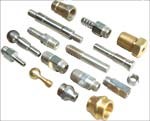Affordable, Flexible Production Turning
A newly introduced bar machine from Romi Machine Tools is purpose built to perform both mid-range production (500 to 10,000 pieces) and short run, high mix applications.
Flexibility is the watchword in precision turned parts manufacturing. Equipment makers are tasked with demands from metalworking shops to provide machines and accessories that can handle longer production runs, yet still be easily and quickly changed over to accommodate short part runs. Historically, these two seemingly conflicting manufacturing modes would be accomplished by machines purpose built for each.
A newly introduced bar machine from Romi Machine Tools (Erlanger, Kentucky) is purpose built to perform both mid-range production (500 to 10,000 pieces) and short run, high mix applications. It is called the Centur CNC 30G and uses its Fanuc 0i-Mate control to help it be responsive to flexible production demands. Processing speeds are fast, and the machine uses interactive canned cycles for frequently performed operations to simplify and speed up programming.
The manufacturer is offering this machine with its own bar feeder. For production volume machining, this option is a good one. The feeder uses custom software that interfaces directly with the machine CNC, so programming the machine automatically programs the bar feeder. It uses magazine feed so it can be stocked for long production runs. It accommodates standard length bars. The base price for the machine and bar feeder is $50,000.
As the drawing shows, the gang tool mounting surfaces are arranged on the cross slide in a "U" shape. Tools can be fed from the right side or the left, and endworking operations use the tools mounted on the back slide. At the top of the drawing, notice the gang plate is angled for clearance. It is a ten-station system.
On one of the stations, a mechanical bar puller with a built-in cut-off tool is used. The system also carries two external toolholders, two boring bar holders, one double boring bar holder and five reduction sleeves. Chips are channeled from the cutting zone to a center-rear discharge chip conveyor.
Recently, live tools have become available for mounting on these T-slotted plates for milling and drilling operations. These auxiliary live spindles can generate 15,000 rpm for high speed milling/drilling or for heavier metal removal, a reducer gives 3,000 rpm, but much higher torque.
Also contained on the cross slide is a parts catcher. It is built into the cross slide carrier and is actuated when the cut-off tool moves toward the workpiece.
A 7.5-hp AC motor drives the spindle on the Centur. Its maximum diameter bar capacity for round stock is 1.625 inches; 1.25 inches for square and 1.0 inch for hex. Programmable spindle speeds range from 5 to 5,000 rpm.
Rather than use size-specific guide tubes to accommodate various bar sizes, this spindle uses a modular guide tube. For a given size or shape of barstock, five nylon discs are machined to size and fitted into the spindle bore. Five spacers keep the discs in place.
Romi sees this machine and bar feed combination as a technology bridge for screw machine shops looking to transition from single-spindle automatics to CNC production turning without investing huge amounts of capital. Moreover, for shops that need production capability that can be quickly changed from job to job, the Centur is designed to accomplish the task. Automated operation using the magazine loader, ten-tool capacity gang plates, part catcher and CNC enable it to run long or short volumes unattended or lightly attended.
Related Content
5-Axis Machining Centers Transform Medical Swiss Shop
Traditionally a Swiss machine shop, Swiss Precision Machining Inc. discovers a five-axis machining center that has led the company to substantial growth. (Includes video.)
Read MoreWhen a CNC Turn-Mill Doesn’t Turn
A shop in Big Sky Country uses a B-axis multitasking machine to produce complex, prismatic medical parts that require no turning complete from barstock.
Read MoreDoes a Scanning Probe Make Sense on a Swiss-Type?
Swiss-types have limited tooling capacity, but there can be advantages to giving up some of that capacity to take advantage of a touch probe — in fact, a scanning probe — to enable in-process part measurements.
Read MoreShop Optimizes its Swiss-Turning Flexibility
Paramount Machine uses various Swiss-type lathes, some with a B axis, to produce parts more effectively than it did on conventional chucker lathes. Today, nearly every job under 1.5 inches in diameter runs across those machines even if the batch size is a mere 5 pieces.
Read MoreRead Next
5 Aspects of PMTS I Appreciate
The three-day edition of the 2025 Precision Machining Technology Show kicks off at the start of April. I’ll be there, and here are some reasons why.
Read MoreEmerging Leaders Nominations Now Open
Here’s your chance to highlight a young person in your manufacturing business who is on the path to be a future leader moving your company forward.
Read MoreDo You Have Single Points of Failure?
Plans need to be in place before a catastrophic event occurs.
Read More










.jpg;maxWidth=300;quality=90)













